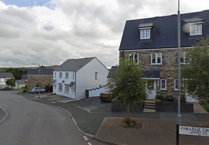1895 brought new beginnings to the Bodmin and Wadebridge Railway line. For the first time in its history, it was part of a network. Investment from the London and South Western Railway to overhaul the line had begun to pay fruit and for the first time, a passenger could get on a train at Bodmin North and go all the way to London Waterloo (a journey ranging in time from seven hours and 18 minutes to nine hours with a change at Wadebridge)
The few years prior to the railway’s connection with the LSWR network upon the construction of the North Cornwall Line from Halwill had seen major work take place on the Bodmin and Wadebridge line. By 1882, a friendlier relationship between the LSWR and its great rival, the Great Western Railway (GWR) had seen discussions take place about connecting the GWR’s line to Wadebridge, which it would do via Bodmin General and also to improve the Bodmin and Wadebridge line itself. The improvements were needed as the line had been built relatively primitively, with sharp curves and lightly laid track.
The suspension of railway passenger services on the Bodmin and Wadebridge line took effect from November 1, 1886 and would not resume until 1895.
During this time, the GWR joined the line with its own connection. After the opening of the connection from Bodmin Road (now Bodmin Parkway), located a few miles from Bodmin and Bodmin General, adjacent to the town centre on May 27, 1887, the connection between Bodmin General and a junction at Boscarne was opened the following year on September 3, 1888.
The reconstruction of the Bodmin and Wadebridge line to be suitable for the fully fledged railway era was a long and protracted exercise, not least as significant investment from the LSWR was needed to construct the North Cornwall Railway from Halwill Junction to Wadebridge, with raising the capital to build that line providing difficult and delaying.
During this time, the Bodmin and Wadebridge would see significant improvements including the substantial easing of sharp curves at Grogley and Dunmere as well as vast improvements to the section between Boscarne Junction and Bodmin North and an extension at Wadebridge Station to allow the connections with the nascent North Cornwall line.
The new beginnings for the Bodmin and Wadebridge line would begin on November 1, 1895 with LSWR once again running trains on the Bodmin and Wadebridge section of the line. Now, it was connected to a network as opposed to being a curious outlier miles away from any semblance of connections as it once was.
New passenger stations were provided, too, with halt platforms installed at Grogley, Nanstallon and Dunmere opening on July 2, 1906. There is also a reference to a short-lived St Lawrence Hospital Platform, near the road to Nanstallon which opened at the same time and closed in 1917; this is presumed to have been a platform to serve the nearby county lunatic asylum.
Despite the major changes, traffic on the line remained comparatively light and services during the time after reopening were powered by LSWR Class H13 steam railcars, seating 40 passengers. After the post World War I rationalising of railway companies, the LSWR became part of the Southern railway network.
In 1933, the small branch line to Ruthernbridge, which had been built to serve mineral mines in the area was permanently closed after the decline of the industry in the area, with very little remaining of that particular branchline today.
The beginning of World War II saw the Bodmin and Wadebridge line play its part in the war effort, and also receive bomb damage too. An armoured train, powered by a LNER Class F4 tank engine was stationed at Wadebridge and until 1941, was constantly “in steam”, patrolling the railway line from Padstow to Bodmin as well as Bodmin to Fowey and crewed by the Royal Tank Regiment, the Royal Engineers and soldiers from Poland.
The bomb damage came in 1941, when in an attack on August 7 of that year, there was bomb damage to Bodmin North Station after it landed on the nearby Primrose Dairy, and the strafing of an ammunition train climbing from Boscarne Junction towards the GWR station at Bodmin General.
Nationalisation of the railways amid the high cost of the damage sustained to the railways across the United Kingdom post World War II was to be the beginning of the end of the Bodmin and Wadebridge line.
In 1949, Bodmin station was to be renamed to Bodmin North with the GWR station known as Bodmin General, a name which it has kept to this day.
Strict economies came to the line in the 1960s after the Beeching report recommended closure of the line, something which effectively became the death warrant for Cornwall’s first passenger railway line.
A very basic, primitive wooden exchange platform was opened on June 15, 1964, at Boscarne Junction, known as the Boscarne Exchange Platform. No expense was spent on the construction of this connecting platform with no public access other than to cross to the other platform, which would serve as an interchange between a shuttle service from Bodmin North to Boscarne Junction and trains from Bodmin General to Wadebridge; for the sole lighting on the platform was provided by a single oil lamp. As for the “platform” on the Bodmin and Wadebridge side of the railway at Boscarne, there simply wasn’t any. It was on ground level.
No remnants remain of the Boscarne Exchange Platform, which was located metres away from the Boscarne Junction station of the Bodmin and Wenford heritage railway line.
The closure in 1966 of the North Cornwall Line between Halwill and Wadebridge meant that once again, the Bodmin and Wadebridge railway was a lonely branch line, albeit serving Padstow until the beginning of 1967.
On January 30, 1967, the final day of regular passenger services on this historic line came to pass after serving passengers and goods alike for 133 years when, after the last train arrived at its destination, the Bodmin and Wadebridge railway as we’d known it, was no more.
However, that wasn’t to be the end of the story. The Bodmin to Wenfordbridge section of the line, which had only ever been a goods line, survived thanks to the Wenford clay dries and from 1967 to 1983, the remnants of the line became a dedicated branch for the private sidings of the china clay operation from Bodmin General to Wenfordbridge.
In many ways, it was the survival of this small, relatively insignificant part of the railway which led to the enjoyment we have of what became of the railway; for in 1974, a preservation society was formed which would become the Bodmin and Wenford Railway, connecting Bodmin General with Bodmin Parkway and Boscarne Junction, reopening once again to Bodmin Parkway in 1990 and Boscarne Junction in 1996. Long held ambitions to connect the line to Wadebridge once again have not yet come to pass.
But what of the rest of the line? Chances are, if you weren’t aware of the history of the line, you’d know it better as the Camel Trail, a surfaced multi-use trail popular with walkers, cyclists and horse riders running pretty much the exact route once taken by the railways.
Much like the Parkland Walk in London, which runs on the remains of the Northern Heights extension line, the platforms where trains once stopped are still extant, with replica Southern railway era signs reminding people of the names of the stations that once were operational.
For Wadebridge station, while most of the station site now forms the ‘Southern Way’ housing estate, with the sidings also playing host to a Co-Op supermarket and Wadebridge Town Council car park, the main station building still remains in use as the John Betjeman Centre; named after the railway campaigner and poet laureate who came to come Cornwall home.
As for Bodmin North? Nothing remains of it today. The site where the station stood is now the Berrycoombe Car Park, with the Original Factory Shop, once known as the Railway Stop, a health centre and a number of small businesses occupying the land where in 1834, wharves once stood with a supermarket, now a Sainsburys opening at the bottom of the site in 1987 after spending a period as a lorry park.
You can still make out the route of the railway line from Bodmin North as you approach the Camel Trail, on an extremely potholed and badly maintained road linking Berrycoombe Road with the delivery entrance for the Sainsburys supermarket.
Although, you wouldn’t see anything there today to suggest this was the place where Cornwall’s passenger railway story began in 1834.





Comments
This article has no comments yet. Be the first to leave a comment.